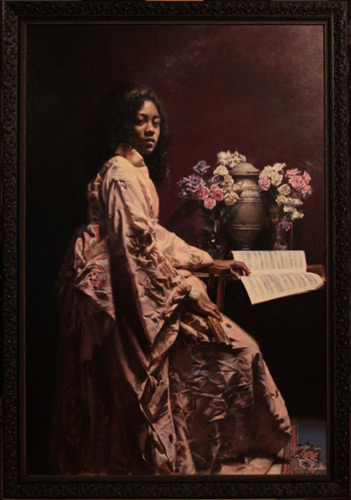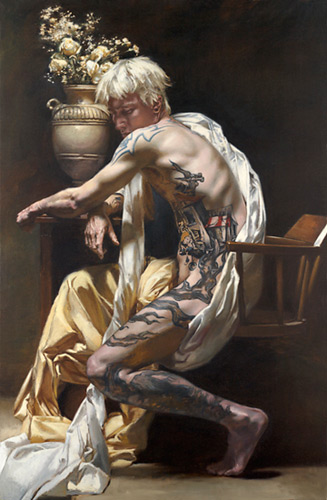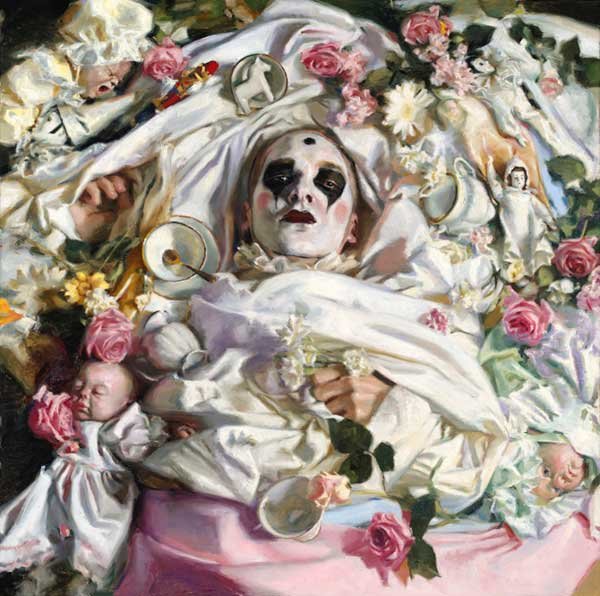Although Teresa Oaxaca is largely focused on perfecting her techniques and aesthetic, her body of work already demonstrates her immense talent, eclectic taste, and unreal potential.
Drawing heavily from past traditions and costume, the paintings of Teresa Oaxaca have both a modern flavor and a timeless aura that is truly captivating. “I am as ever concerned with capturing emotions and feelings and communicating those through my subjects,” writes Oaxaca. “I am interested in showing the beauty of the world around me and evoking a sense of joy, wonder, and seriousness.”
Joy, seriousness, and wonder are indeed apropos when considering “The Black Pierrot.” Among a sea of dolls, teacups, and flowers lies a pensive figure with face painted in white, with black around the eyes. The stoic figure looks out at the viewer with an intensity and power that nearly feels intrusive, as if they are peering into our deepest emotions. The rest of the figure is surrounded by an arrangement of colorful objects that appear to grow or exist organically.

Teresa Oaxaca, “Kazumi,” oil on canvas, 45 x 66 in. (c) Teresa Oaxaca 2015
Oaxaca suggests, “Frequently my compositions are spontaneous. When a person comes to me, they occupy a space in my mind. Arrangements form from there until — with excitement — I see the idea I have. The design is both planned and subconscious. For this reason I surround myself with Victorian and Baroque costume, bones, and other things which I find fascinating — I want subject matter to always be at hand.”
While some might find Oaxaca’s use of Victorian and Baroque costume, along with clown-like facial paint, unusual, Oaxaca sees it as part of an established tradition. She suggests, “I was mentored in the 19th-century tradition of art, a period which looked back and leaned heavily upon the past. The artistic ideal then was not to reinvent the wheel every day or to deconstruct, but to add to the culture. The dead, as it were, had a very real impact on the present. I like to think that my interest in wigs and costuming of other eras is part of that tradition.”

Teresa Oaxaca, “Patrick,” oil on canvas, (c) Teresa Oaxaca 2015
Recently, Oaxaca has pushed herself to “stay fit” with her drawing skills. “The drawings stand on their own and serve to loosen my hand and give my eye a rest from a long painting project,” she says. “I draw and paint to make finished works. I like to alternate between the two.” In fact, so skilled is Oaxaca with her drawing that the artist has established regular workshops around the country focused on improving techniques with charcoal and portraiture.
Oaxaca’s prowess in portraiture extends into paint as well. “Kazumi” is an exceptional example of the artist’s outstanding talent in this time-honored genre. Presented in seated full length is a stoic African-American sitter. Lit from directly above, the picture is dominated by the lavish kimono robe adorning the subject. Oaxaca’s ability to capture the light as it falls on the silky texture is absolutely stunning. Every fold, wrinkle, and stitch is captured with acute observation. While the robe occupies a large portion of the picture, the face of the sitter is magnetic as well — her confidence and naturalistic visage radiate from the surface. Next to the subject sits a table with vase and floral arrangement, which also serves as evidence that Oaxaca is well versed in still life.

Teresa Oaxaca, “Remembrance,” oil on canvas, 32 x 44 in. (c) Teresa Oaxaca 2015
Opportunities to meet and learn from Oaxaca are numerous and feature all across the country, with room still available in many. To learn more about Oaxaca’s workshops, visit here.
To learn more, visit Teresa Oaxaca.
This article was featured in Fine Art Today, a weekly e-newsletter from Fine Art Connoisseur magazine. To start receiving Fine Art Today for free, click here.







